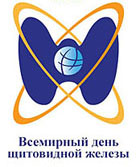ТИРОНЕТ – все о щитовидной железе Для специалистов Журнал Тиронет 2011 год № 4
Диагностика и лечение болезни Грейвса у детей и подростков: трудности и противоречия
Розалинд Браун
Под редакцией В.В. Фадеева
Заключение
БГ у детей, так же как и у взрослых, является основной причиной тиреотоксикоза, однако в отношении подходов к диагностики и лечению имеются существенные различия. Так же как и у взрослых, опрделение АТ-рТТГ является относительно недорогим и удобным методом при не вполне ясном диагнозе, позволяя отличить БГ от других причин тиреотоксикоза. Однако, врач должен помнить о различиях методов определения АТ-рТТГ. В большинстве случаев у детей и подростков, особенно препубертатного возраста, продолжительность медикаментозной терапии составляет более 2-х лет. Кроме того, дети более чувствительны к гепато-токсическому эффекту ПТУ. У пациентов с клиническими и лабораторными признаками тяжелого тиреотоксикоза на момент постановки диагноза требуется больше времени для достижения ремиссии. Последние данные свидетельствуют о том, что быстрый ответ на терапию (через 3-6 месяцев) может быть лучшим предиктором для прогнозирования наступления ремиссии. Многие детские эндокринологи, особенно в Северной Америке, все больше выбирают терапию 131I в качестве основного метода лечения БГ у детей. Тем не менее, данных относительно отдаленной безопасности этого метода лечения немного, особенно у детей младше 10 лет, относящихся к группе высокого риска и имеющих высокую ожидаемую продолжительностью жизни. Мы надеемся, что в скором будущем разработка специфичных антагонистов рецептора ТТГ позволит целенаправленно, эффективно и безопасно проводить лечение БГ.
Литература
1. Smith BR, Sanders J, Furmaniak J. TSH receptor antibodies. Thyroid. 2007 0ct;17(10):923-38.
2. Brown RS. Autoimmune thyroid disease: unlocking a complex puzzle. Curr Opin Pediatr. 2009 Aug;21(4):523-8.
3. Segni M, Leonardi E, Mazzoncini B, Pucarelli I, Pasquino AM. Special features of Graves’ disease in early childhood. Thyroid. 1999 Sep;9(9):871-7.
4. Shulman DI, Muhar I, Jorgensen EV, Diamond FB, Bercu BB, Root AW. Autoimmune hy-perthyroidism in prepubertal children and adolescents: comparison of clinical and biochemi-cal features at diagnosis and responses to medical therapy. Thyroid. 1997 0ct;7(5):755-60.
5. Rivkees SA, Dinauer C. An optimal treatment for pediatric Graves’ disease is radioiodine. J Clin Endocrinol Metab. 2007 Mar;92(3):797-800.
6. Botero D, Brown RS. Bioassay of thyrotropin receptor antibodies with Chinese hamster ova-ry cells transfected with recombinant human thyrotropin receptor: clinical utility in children and adolescents with Graves disease. J Pediatr. 1998 Apr;132(4):612-8.
7. Zophel K, Roggenbuck D, Wunderlich G, Schott M. Continuously increasing sensitivity over three generations of TSH receptor autoantibody assays. Horm Metab Res. 2010 Nov;42(12):900-2.
8. Ajjan RA, Weetman AP. Techniques to quantify TSH receptor antibodies, Nat Clin Pract Endocrinol Metab. 2008Aug;4(8):461-8.
9. Costagliola S, Morgenthaler NG, Hoermann R, Badenhoop K, Struck J, Freitag D, et al. Se-cond generation assay for thyrotropin receptor antibodies has superior diagnostic sensitivity for Graves’ disease. J Clin Endocrinol Metab. 1999 Jan;84(1):90-7
10. Smith J, Brown RS. Persistence of thyrotropin (TSH) receptor antibodies in children and adolescents with Graves’ disease treated using antithyroid medication. Thyroid. 2007 Nov;17(11):1103-7.
11. Pedersen IB, Handberg A, Knudsen N, Heickendorff L, Laurberg P. Assays for thyroid-stimulating hormone receptor antibodies employing different ligands and ligand partners may have similar sensitivity and specificity but are not interchangeable. Thyroid. 2010 Feb;20(2):127-33.
13. Hermsen D, Eckstein A, Schinner S, Willenberg HS, Thiel A, Scherbaum WA, et al. Repro-ducibility of Elecsys anti-TSHR testresults in a lot-to-lot comparison. Horm Metab Res. 2010 Apr;42(4):295-7
14. Hovens GC, Buiting AM, Karperien M, Ballieux BE, van der Pluijm G, Pereira AM, et al. A bioluminescence assay for thyrotropin receptor antibodies predicts serum thyroid hormone levels in patients with de novo Graves’ disease. Clin Endocrinol (Oxf). 2006 Apr;64(4):429-35.
15. Kamijo K, Murayama H, Uzu T, Togashi K, Kahaly GJ. A novel bioreporter assay for thyro-tropin receptor antibodies using a chimeric thyrotropin receptor (mc4) is more useful in differentiation of Graves’ disease from painless thyroiditis than conventional thyrotropin-stimulating antibody assay using porcine thyroid cells. Thyroid. 2010 Aug;20(8):851-6.
16. Lytton SD, Kahaly GJ. Bioassays for TSH-receptor autoantibodies: an update. Autoimmun Rev. 2010 Dec;10(2):116-22.
17. Glaser NS, Styne DM. Predicting the likelihood of remission in children with Graves’ dis-ease: a prospective, multicenter study. Pediatrics. 2008 Mar;121(3):e481-8.
18. Rahhal SN, Eugster EA. Thyroid stimulating immunoglobulin is often negative in children with Graves’ disease. J Pediatr Endocrinol Metab. 2008 Nov;21(11):1085-8.
19. Rivkees SA, Stephenson K, Dinauer C. Adverse events associated with methimazole therapy of graves’ disease in children. Int JPediatr Endocrinol. 2010;2010:176970.
20. Cooper DS. Antithyroid drugs. N Engl J Med. 2005 Mar 3;352(9):905-17.
21. Cooper DS, Rivkees SA. Putting propylthiouracil in perspective. J Clin Endocrinol Metab. 2009 Jun;94(6):1881-2.
22. ATA Guidelines. Hyperthyroidism and other causes of thyrotoxicosis: Management guide-lines of the American Thyroid Association and American Association of Clinical Endocri-nologists. Thyroid (2011) vol 21; 6; 593-630
23. Brown RS. Disorders of the Thyroid Gland in Infants, Children, and Adolescents. In DeGroot L.J., Thyroid Disease Manager, http://www.thyroidmanager.org/, published by En-docrine Education, Inc, South Dartmouth, MA, USA
24. Rivkees SA, Szarfman A. Dissimilar hepatotoxicity profiles of propylthiouracil and methi-mazole in children. J Clin Endocrinol Metab. 2010 Jul;95(7):3260-7.
25. Kaguelidou F, Carel JC, Leger J. Graves disease in childhood: advances in management with antithyroid drug therapy. Horm Res 2009;71:310-317
26. Teng CS, Yeung RT. Changes in thyroid-stimulating antibody activity in Graves’ disease treated with antithyroid drug and its relationship to relapse: a prospective study. J Clin En-docrinol Metab. 1980 Jan;50(1):144-7.
27. Bliddal H, Kirkegaard C, Siersbaek-Nielsen K, Friis T. Prognostic value of thyrotrophin binding inhibiting immunoglobulins (TBII) in longterm antithyroid treatment, 131I therapy given in combination with carbimazoleand in euthyroidophthalmopathy. Acta Endocrinol (Copenh). 1981 Nov;98(3):364-9.
28. Lippe BM, Landaw EM, Kaplan SA. Hyperthyroidism in children treated with long term medical therapy: twenty-five percent remission every two years. J Clin Endocrinol Metab. 1987 Jun;64(6):1241-5.
29. Bergman P, Auldist AW, Cameron F. Review of the outcome of management of Graves’ disease in children and adolescents. J Paediatr Child Health. 2001 Apr;37(2):176-82.
30. Raza J, Hindmarsh PC, Brook CG. Thyrotoxicosis in children: thirty years’ experience. Acta Paediatr. 1999 Sep;88(9):937-41.
31. Hamburger JI. Management of hyperthyroidism in children and adolescents. J Clin Endo-crinol Metab. 1985 May; 60(5):1019-24.
32. Kaguelidou F, Alberti C, Castanet M, Guitteny MA, Czernichow P, Leger J. Predictors of autoimmune hyperthyroidism relapse in children after discontinuation of antithyroid drug treatment. J Clin Endocrinol Metab. 2008 Oct;93(10):3817-26.
33. Cappelli C, Gandossi E, Castellano M, Pizzocaro C, Agosti B, Delbarba A, et al. Prognostic value of thyrotropin receptor antibodies (TRAb) in Graves’ disease: a 120 months prospec-tive study. Endocr J. 2007 Dec;54(5):713-20.
34. Rivkees SA, Cornelius EA. Influence of iodine-131 dose on the outcome of hyperthyroidism in children. Pediatrics. 2003 Apr;111(4 Pt 1):745-9.
35. Ron E, Lubin JH, Shore RE, Mabuchi K, Modan B, Pottern LM, et al. Thyroid cancer after exposure to external radiation: a pooled analysis of seven studies. Radiat Res. 1995 Mar;141(3):259-77.
36. Nikiforov Y, Gnepp DR, Fagin JA. Thyroid lesions in children and adolescents after the Chernobyl disaster: implications for the study of radiation tumorigenesis. J Clin Endocrinol Metab. 1996 Jan;81(1):9-14.
37. Williams D. Thyroid cancer and the Chernobyl accident. J Clin Endocrinol Metab. 1996 Jan;81(1):6-8.
38. Rivkees SA, Sklar C, Freemark M. Clinical review 99: The management of Graves’ disease in children, with special emphasis on radioiodine treatment. J Clin Endocrinol Metab. 1998 Nov;83(11):3767-76.
39. Sherman J, Thompson GB, Lteif A, Schwenk WF, 2nd, van Heerden J, Farley DR, et al. Surgical management of Graves disease in childhood and adolescence: an institutional experience. Surgery. 2006 Dec;140(6):1056-61; discussion 61-2.




